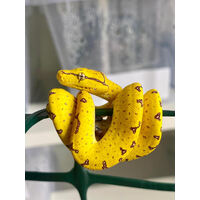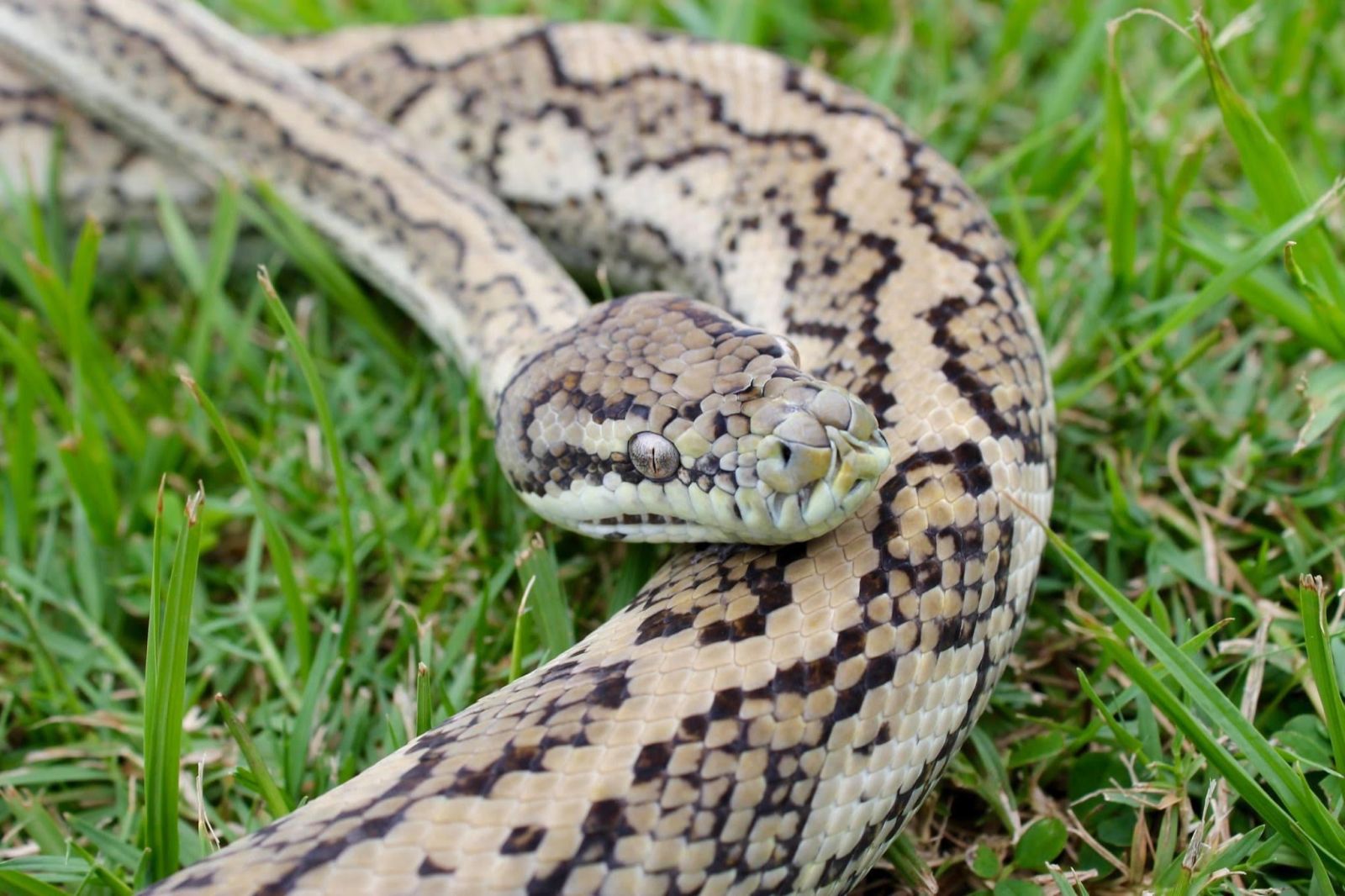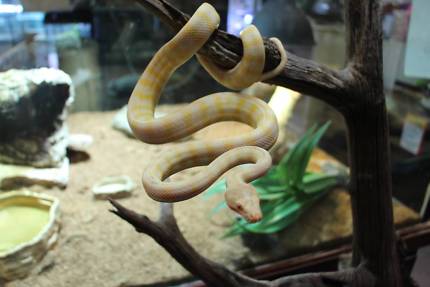Australian Snake Care Guide
Author: Bo Marsh Date Posted:27 May 2023

Learn everything you need to know about caring for Australian snake's. This is a easy to read, no nosense guide to caring for your snake. Learn about feeding, temperature, humidity and general health.
Feeding
Snakes should be fed according to the size of their mid-section. They can eat prey which is double the size of their bodies, meaning most adults can easily consume jumbo rats, rabbits, and adult quail.
During the summer months (1st of December to 28th of February in Australia) snakes are most active. They require the heat to be able to digest their food, therefore, in winter (1st of June to 31st of August in Australia) many snakes will go off their food for months. This is to ensure that their prey does not rot inside them which would be fatal for the snakes. In winter they go into what is called Reptillian Brumation. Similar to hibernation, but not fully switching off. Snakes have an amazing ability to store all the nutrients and fat from the things they eat, ensuring they have enough reserves to get through winter easily. This happens both in the wild and captivity so do not worry if your snake begins refusing its feed when the temperature starts to drop.
During summer, a good feeding routine for an adult snake would one rat every two weeks, hatching/yearling snakes can be fed more often as they are growing and need a more continuous food source, so one rat/mouse per week is adequate for them.
Also, depending on what species of snake you own its food size may vary. For species such as Childrens Pythons and Stimsons Pythons etc the maximum food size for an adult would be a jumbo mouse or sub adult rat. As a hatchling you would need to start off with feeding it pinkie mice, or whatever the breeder had it feeding on prior to you purchasing it. Species such as Black Headed Pythons can go straight onto pinkie rats as hatchlings, as they are a much larger species of snakes.

Rat/Mouse Sizes
- Pinkie Mice
- Fuzzie Mice
- Hopper Mice
- Sub Adult Mice
- Adult Mice
- Jumbo Mice
- Pinkie Rat
- Fuzzie Rat
- Hopper Rat
- Sub Adult Rat
- Adult Rat
- Jumbo Rat
Temperature & Humidity
To ensure your snake stays in tip top health it is important to have the temperature and humidity correct in their enclosure. Too cold and you run the risk of them catching a respiratory infection, too hot and your snake will die of heat exhaustion.
Depending on what type of snake you have, the correct heat may vary, but a safe temperature to stick to is 31 degrees. Always make sure that there is also a slightly cooler spot in the enclosure for your snake to reside to if they start feeling too hot. This should be only a few degrees less, sitting at around 28 degrees.A way to make sure there is a hot and cool spot in the enclosure is by placing the heat source on one end, so that the other end of the enclosure does not have the direct source of heat. Night time heat should also be available, sitting at no less than 25 degrees.
It is important for snakes to always have a heat source as they are cold blooded animals so rely solely on the heat for their bodies to function.
To make sure you have complete control of the temperature in your snake’s enclosure we strongly recommend purchasing a thermostat. This helps you control the heat in the enclosure and also stops it from going over the desired temperature. It will also stop the enclosure from getting too cold by automatically switching on the heat if the probe reads that the temperature is below what you have set it to be.
A water source should always be available for the snake, not only does this allow the snake to keep hydrated but it also creates a good level of humidity inside the enclosure. Depending on what species of snake you own, some may require more humidity than others. For example, a Woma Python would need less humidity in its enclosure verses a jungle python. This is due to the climates these snakes live in. Woma Pythons live in the deserts, jungle pythons live in jungles/rainforests. For snakes that require a larger amount of humidity a way you can keep this up is by using a spray bottle filled with water and spraying down the enclosure once every few days.
We also strongly recommend upping the humidity level in your snake’s enclosure once you see that the snake is coming up for a shed, higher humidity rates helps the snake shed its skin easily and in one piece.
Health
Your snake will remain healthy if the correct care is given in maintaining a healthy environment. A very common health issue in snakes is respiratory infections. These can be caused by multiple things, but the main one being that the snakes have gotten too cold. This causes a fluid build-up in the lungs and will make breathing very difficult for the snake. To find out whether your snake has a respiratory infection listen closely to their breathing, it will sound crackly, and there will most likely be a lot of clear mucus in the mouth. Often there will also be mucus bubbles being blown out of the nostrils. The snake will also go off its food when it is feeling ill, generally before you even see or hear the tell-tale signs of a respiratory infection.
So, if you notice that your snake has been refusing feeds continuously in summer, it is worth taking it in for a check-up with your local vet. These signs above are not to be taken lightly, a respiratory infection at this stage is serious and the snake will need urgent medical attention, if ignored this will be fatal.
Another common health problem for snakes is mites. Mites can be contracted from other infested snakes, or if they have come from a place which had poor sanitation and quarantine methods. Therefore, it is important to always purchase your reptile from a reputable breeder. If left untreated, mites will cause severe discomfort in your snake, blindness, blood-borne diseases and even death. Mites will often get under the snake’s scales and also in their eyes. Ways to tell if your snake has mites is by looking very closely at their face. You will see tiny white specs moving over the snake’s head and also near its eyes. Your snake may also be soaking itself in its water bowl for long periods of time to try and get the mites off. Mites require warmth and moderate levels of humidity to successfully moult and grow.
If you suspect that your snake has mites, contact your closest reptile vet. You will most likely be required to take the snake in and have blood tests done, depending of the severity of the infestation. The snake will then be put on a treatment program to get back to perfect health.
Ways to prevent mites is by always making sure you thoroughly clean your snake’s enclosure with a strong animal grade disinfectant. We recommend using F10 Disinfectant as it is a veterinary grade disinfectant which is completely animal safe, yet it kills all known diseases including parvovirus!
Also make sure that when you welcome a new scaley friend to your home to put them through a quarantine process, especially if you already own another snake. This is to guarantee that there is no spread of disease and this also gives you the opportunity to monitor the new arrival closely to make sure it too is in perfect health and that there is no risk of cross contamination.
Scale rot can be something some snakes with poor husbandry contract. This is when the snake's enclosure is not thoroughly cleaned and feaces not removed causing a buildup of bad bacteria the snake is then moving around in. Scale rot is when bacteria harbour underneath the scales causing a nasty infection and ultimately rotting away the scales. It is an extremely painful condition for a snake to get and requires urgent and extensive treatment. The snake can be left with nasty scarring if the infection is serious. This is why it is extremely important to always do your research and maintain a sanitary environment for your snake to live in.
Burns can occur to your snake if there is no protection from the heating element in the enclosure. If your snake's enclosure is heated with a heat lamp, you must always ensure there is a light cage around the bulb so the snake cannot accidentally touch the hot bulb. It is also extremely important to connect a thermostat to the heat source to ensure it does not overheat. Heatmats are also a common denominator for causing burns to snakes. When the heat mats are not connected to a thermostat the mat will continually heat to its maximum temperature which is generally always far too hot to touch, and an unsuspecting snake searching for heat will always fall victim to. Burns require urgent medical attention as without it can lead to infection. A visit to your nearest reptile vet will be required.
Certain species of snakes can also be more susceptible to rectal prolapse. Sometimes this can be genetic for a certain snake, but mostly it is due to poor husbandry or feeding incorrect sized food. When a snake's husbandry, or living conditions, is not correct a prolapse can occur. This is why it is extremely important to do plenty of research on the snake you are planning to own to ensure you have correctly set up their enclosures. This includes providing the right temperatures and heat source, ensuring there is clean drinking water always available, providing the correct humidity levels, and providing an environment within the enclosures that closely mimic their natural environment. Feeding a prey item that is too large for the snake can also potentially cause a prolapse in some species. This is why it is always very important to listen to your snake's breeder and take their advice on the size of prey the snake is currently safely eating, and slowly increase it as the snake grows. If you happen to notice your snake has prolapsed, place the snake inside a plastic tub with a damp paper towel on the bottom. It is extremely important not to let the prolapsed tissue dry out as it will then become necrotic. Then immediately take your snake to your nearest reptile vet for treatment.
Regurgitation can also occur in snakes. This is usually a sign of a health concern within the snake. Sometimes it can be as simple as the food item being too big, but generally if you notice your snake has regurgitated its food when it is usually healthy and eating well, it is a cause for concern. Sometimes a simple husbandry checkover can help, the temperatures within the enclosures may have fluctuated too much, become too cold or too hot. Because snakes are cold blooded, they rely solely on heat for their digestive systems to properly function. If it is too cold within the enclosure, their bodies and gastrointestinal tract slow right down and they are no longer able to digest their prey. This is then a health concern for the snake as the prey item can rot inside the digestive system causing many health problems. Regurgitation can also be a sign of other illnesses in your snake so a visit to a reptile vet is always in order to get to the root cause and get a treatment plan ASAP. All in all, regurgitation is nothing to think lightly of and always warrants a visit to the vet.
Enrichment
Providing enrichment for your snake is a great way to not only keep your snakes happy, but also to keep them stimulated and encourage their natural behaviours. Because snakes rely solely on their scent and vision, focusing on these areas for enrichment is key. By adding certain scents or objects to their enclosures, it is encouraging them to actively move around to find the new scent and explore where it is coming from. It can be as simple as cutting some small branches off a tree outside and putting them in the enclosure, adding logs from outside, leaf litter, rocks, new hides etc. All of these things stimulate the snake and encourage natural behaviours which sometimes can be forgotten due to the lack of natural elements within their enclosures. Adding enrichment to your snake's environment can be extremely beneficial to their health as it encourages movement, stimulates their senses, encourages breeding and all natural behaviours normally seen in the wild.
Final Thoughts
Remember to always do a large amount of research before purchasing any new reptile, as most have different needs. This will then ensure there are no problems and that both you and the snake are happy!

 for Dog Products & Supplies
for Dog Products & Supplies
 for Dog Food
for Dog Food
 for Cat Products & Supplies
for Cat Products & Supplies
 for Cat Food
for Cat Food
 for Reptiles
for Reptiles
 for Small Animals
for Small Animals
 for Aquarium
for Aquarium
 for Bird Products & Supplies
for Bird Products & Supplies

